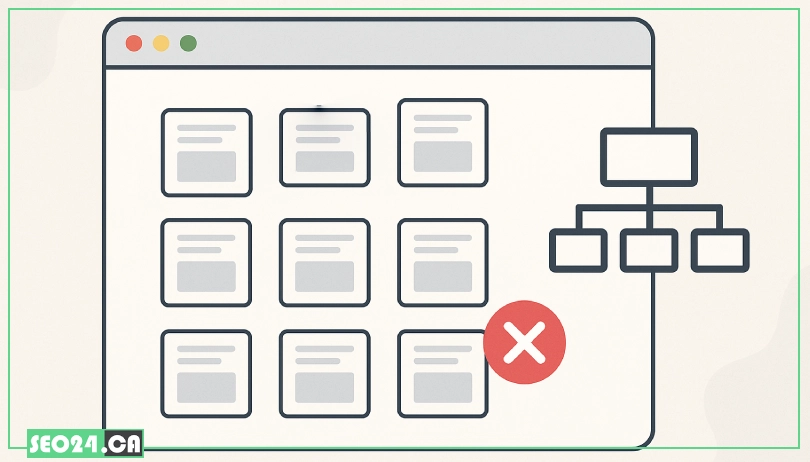
Pages Exclude from Sitemap
Are all your website pages meant to be in your sitemap? You might be surprised to learn that including certain pages can actually hurt your SEO. In this guide, we’ll show you why excluding specific types of pages is essential for improving your site’s search performance. Keep reading!
📋 Pages list in short
📍Duplicate pages
📍Paginated pages
📍Non-canonical pages
📍Archive pages
📍Redirected pages (3xx), Missing pages (4xx) and Error pages (5xx)
📍Comment URLs
📍No-index pages
📍Resource pages useful to site visitors but don’t serve as landing pages
📍Site result search pages
📍Shared via email pages
Table of Contents
Why Exclude Certain Pages from a Sitemap?
Not every page on your website deserves a place in your sitemap. Being selective can help your SEO efforts by ensuring that search engines focus on your most valuable content. Here’s why excluding certain pages is a smart move:
- Wasted Crawl Budget: Search engines have a limited crawl budget for each site. Including low-value or irrelevant pages can waste that budget, causing more important pages to be crawled less frequently or missed altogether.
- Indexing Unwanted Content: Pages like thank-you pages, login screens, or internal test URLs don’t need to be indexed. Including them in your sitemap might lead to them appearing in search results, cluttering your site’s presence and confusing users.
- Diluted Link Equity/Authority: Every link on your site shares a bit of your overall authority. When unnecessary pages are included in the sitemap, they can siphon link equity away from your key landing or product pages, weakening their SEO performance.
- Preventing SEO Penalties/Issues: Duplicate content, thin pages, or dynamically generated URLs can hurt your SEO if indexed. By keeping these pages out of your sitemap, you reduce the risk of algorithmic penalties or ranking issues.
📖 Read More: How to Create a Sitemap for Your Website?
Categories of Pages to Exclude from Your Sitemap (with Examples)
Not all web pages add SEO value; some can actually harm your site’s performance if indexed. To keep your sitemap clean and strategic, it’s important to know which types of pages to leave out. Below, we’ll break down the most common categories of pages you should exclude, along with real examples to guide your decision.
Pages with noindex Tag
Pages that contain a noindex meta tag are specifically marked to be excluded from search engine indexes. Including them in your sitemap sends conflicting signals: you’re telling search engines both to find and not index the same page. This can waste crawl budget and reduce your sitemap’s overall effectiveness.
Examples:
- Thank-you pages after form submissions
- Temporary landing pages for A/B testing
- Internal admin or preview pages
Duplicate Content Pages (Non-Canonical Versions)
Pages that contain the same or very similar content as other pages should only have the canonical version included in the sitemap. Listing all variants confuses search engines and dilutes ranking signals, which can harm your visibility.
Examples:
- Both HTTP and HTTPS versions of the same page
- URLs with tracking parameters (e.g., ?utm_source=)
- Print-friendly versions of articles
Thin Content or Low-Quality Pages
Pages with very little content or poor-quality information don’t add SEO value. Including them in your sitemap can lower your site’s overall content quality signals and affect your rankings.
Examples:
- Category or tag pages with minimal or no product/content
- Empty search results pages
- Placeholder or “coming soon” pages
Pages Blocked by robots.txt
If a page is blocked in your robots.txt file, search engines are instructed not to crawl it. Including such pages in your sitemap is redundant and potentially problematic, especially if it contains private or sensitive information.
Examples:
- Backend login panels (e.g., /admin/, /wp-login.php)
- System folders like /cgi-bin/ or /cart/
- Internal search or filter result pages
Orphan Pages with No Value
Orphan pages aren’t linked from anywhere else on your website. If they also lack SEO or user value, they shouldn’t be included in the sitemap since search engines struggle to assess their relevance and trustworthiness.
Examples:
- Test or staging pages left live
- Expired promotional landing pages with no internal links
- Forgotten pages only accessible via direct URL
Redirected Pages (301s, 302s)
Pages that automatically redirect to other URLs don’t need to be in your sitemap. They offer no standalone content and can clutter your sitemap, wasting crawl budget.
Examples:
- Old URLs that now redirect to updated product pages
- Moved blog posts with 301 redirects
- Temporary redirects used during site maintenance
Pages that Require User Login/Sensitive Data
Pages that are only accessible after logging in or those that contain personal/sensitive data should never be in a public sitemap. These pages are not intended for indexing and can create serious privacy or security issues if exposed.
Examples:
- User dashboards or account settings pages
- Checkout or order history pages
- Internal team collaboration tools or private content libraries
📖 Read More: Best Sitemap Generator Tools for Your Website
How to Remove URLs/Pages from Sitemap?
Keeping your sitemap clean and SEO-friendly requires more than just knowing what to exclude—you also need the right tools and practices in place. Here’s how to make sure irrelevant or harmful pages stay out of your sitemap:
- Configure Your Sitemap Generator/Plugin: Most modern CMS platforms and SEO tools let you choose which content types or taxonomies to include. Use these settings to exclude tags, archives, or specific pages that don’t belong in your sitemap.
- Regular Sitemap Audits: Conduct routine reviews of your sitemap using tools like Google Search Console or Screaming Frog to identify and remove outdated, redirected, or irrelevant URLs.
- Proper noindex and robots.txt Implementation: Use noindex meta tags for pages you want excluded from indexing, and update your robots.txt file to block crawl access to entire folders or low-value sections of your site.
- Implement Canonical Tags Correctly: For duplicate or near-duplicate pages, make sure the canonical tag points to the preferred version—and only include that version in your sitemap to prevent dilution of ranking signals.
💡If you’re unsure how to implement these steps or want a clean, SEO-optimized sitemap tailored to your site’s needs, our expert SEO service in Toronto is here to help. Our team can handle the technical details and ensure your sitemap supports your broader SEO goals.
Conclusion
A well-structured sitemap can significantly improve your website’s visibility, but including the wrong pages can have the opposite effect. By excluding pages like duplicates, redirects, and low-value content, you help search engines focus on what truly matters—your most valuable, index-worthy pages. It’s a small adjustment that can make a big difference in long-term SEO performance.
💡Need help reviewing or optimizing your sitemap? Our digital marketing agency in Toronto is ready to assist you with expert SEO guidance tailored to your business. Contact with our specialists!
FAQ
No. 404 pages are broken links and should never be included in a sitemap. They waste crawl budget and can hurt SEO.
Use your sitemap plugin or generator settings to deselect them, apply a noindex tag, or block them via robots.txt.
Related Posts
Learn what SEO is and why it's crucial for your business. Find out how optimizing your website can boost…
by
Having a great website is just the first step. To get people to visit it, they need to be…
by
As voice search becomes more popular, it's clear that people are changing how they look for information online. Users…
by
With the rise of zero-click searches, ranking at the top of Google's search results has taken on a new…
by


